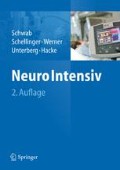Zusammenfassung
Die Neuroradiologie stellt krankhafte Veränderungen am Nervensystem, an seinen umgebenden Strukturen und an seinen versorgenden Gefäßen dar. Dabei werden verschiedene bildgebende Verfahren genutzt. Die wesentlichen Modalitäten sind die Computertomographie, die Magnetresonanztomographie und die Angiographie. Zusätzlich kommen noch immer das konventionelle Röntgen und die Myelographie zum Einsatz. Eine suffi ziente bildgebende Diagnostik und deren Interpretation werden umso wichtiger, je schlechter der Patient klinisch-neurologisch untersucht werden kann. Demzufolge besitzen die neuroradiologischen Verfahren gerade in der neurologischen und neurochirurgischen Intensivmedizin einen sehr hohen Stellenwert.
Access this chapter
Tax calculation will be finalised at checkout
Purchases are for personal use only
Preview
Unable to display preview. Download preview PDF.
Literatur
Alfke K, Jansen O (2001) Cerebral ischemia. Radiologe 41: 599–607
Jansen O, Schellinger P, Fiebach J, Hacke W, Sartor K (1999) Early recanalisation in acute ischaemic stroke saves tissue at risk defined by MRI. Lancet 12:2036–2037
Kharitonova T, Ahmed N, Thorén M, Wardlaw JM, von Kummer R, Glahn J, Wahlgren N (2009) Hyperdense middle cerebral artery sign on admission CT scan—prognostic significance for ischaemic stroke patients treated with intravenous thrombolysis in the safe implementation of thrombolysis in Stroke International Stroke Thrombolysis Register. Cerebrovasc Dis 27:51–59
Barber PA, Demchuk AM, Zhang J, Buchan AM, ASPECTS Study Group (2000) Validity and reliability of a quantitative computed tomography score in predicting outcome of hyperacute stroke before thrombolytic therapy. Lancet 13:670–674
Schellinger PD, Fiebach JB, Jansen O, et al. (2001) Stroke magnetic resonance imaging within 6 hours after onset of hyperacute cerebral ischemia. Ann Neurol 49:460–469
Schwab S (1999) Neurologische Intensivmedizin. Springer, Heidelberg Berlin
Wiesmann M, Mayer TE, Yousry I, et al. (2002) Detection of hyperacute subarachnoid hemorrhage of the brain by using magnetic resonance imaging. J Neurosurg 96:684–689
Author information
Authors and Affiliations
Editor information
Editors and Affiliations
Rights and permissions
Copyright information
© 2012 Springer-Verlag Berlin Heidelberg
About this chapter
Cite this chapter
Alfke, K., Jansen, O. (2012). Neuroradiologie. In: Schwab, S., Schellinger, P., Werner, C., Unterberg, A., Hacke, W. (eds) NeuroIntensiv. Springer, Berlin, Heidelberg. https://doi.org/10.1007/978-3-642-16911-3_3
Download citation
DOI: https://doi.org/10.1007/978-3-642-16911-3_3
Publisher Name: Springer, Berlin, Heidelberg
Print ISBN: 978-3-642-16910-6
Online ISBN: 978-3-642-16911-3
eBook Packages: Medicine (German Language)

